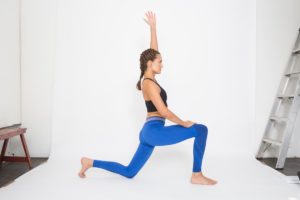Fascial Stretch Therapy is a table based assisted stretching technique that can be performed at home, on the floor or with athletes on the field. Fascial Stretch Therapy is what I sometimes call ‘yoga for lazy people’. While you lie back a therapist moves through a series of gentle stretches, designed to create length not only around the muscle but within the joint capsule.
Fascial Stretch Therapy vs. Yoga.
Fascial stretching is great for people who don’t have the upper body strength to get the most out of yoga or feel they simply can’t keep up! Sometimes slower can be better, with a focus on relaxation to allow the body to open up.
Fascia stretching involves applying traction to the joint. This is the main point of difference to the more familiar yoga stretches. It’s very hard to create traction on your own! Applying traction allows for increased range of motion from the origin of the muscle at the joint, all the way down the limb. This lengthens everything including the soft tissue and tendons encouraging greater circulation throughout the body. Fascial stretching is excellent for improving rate of muscle recovery, essential to athletic performance.
What Makes Fascial Stretch Therapy Different?
When coming into a fascia stretch session, the immediate point of difference is the use of straps on the table. These straps help to immobilise the body allowing the therapist to create traction. The client can completely relax, without feeling they are going to be flipped off the table!
The therapist will usually stretch the entire body, it’s important to do so to complete the lengthening of the fascial net. There are four different lines of fascia or fascial nets in the body. They run from the toes all the way up to the top of the head. Care is taken to assess the body and spend more time on areas which a particularly ‘sticky’. Imagine for a moment the fascia as a fishing net that has a knot in one area. The net will now be pulled around the knot and these pulls will affect the performance of the net as a whole. The knot needs to be unraveled from different directions to get it flat, smooth and fully functioning.
The fascia is much like this net. You can get knots in this soft tissue that cause tightness and pain and can pull your body out of alignment. Fascial stretch therapy is the process of smoothing out these knots and tight spots.
Glute Stretches with Fascial Stretching Therapy
Do you ever get a dull ache in your lower back? Do you have tight hips or shooting pains in your knees? Fascial stretching is excellent for alleviating tightness through the hips and glutes in turn. I always recommend glute stretches to my clients to take home and practice on their own. Stretching is best done regularly to ensure lasting change.
Fascial Stretch Therapy uses slow rhythmic oscillations of the joint in order to stretch the glute. Circular movements allow a calming of the nervous system. If we try to push through pain the body often tenses to protect itself, so fascial stretching is a gentle treatment that shouldn’t cause any pain.
Stretch Therapy at Home
Of course if you can’t get to see a fascial stretch therapist (like myself) in your city then it is important to get into a regular practice of your own.
Floor stretches are best when held for long periods. I recommend clients set a timer for themselves on a four-minute countdown. They then choose a stretch, so let’s say a hamstring stretch, and hold it or work just with this, for four minutes. When the timer stops then you change sides. Even if you only choose two spots on the body, say the hamstrings and the quads, at least you have performed these stretches at a level that will produce actual results. This prevents you from just racing through stretches for the entire body and not really stretching any one spot effectively. Remember to slow down, breathe deeply and give you body time to open up.

